Trendy Japanese Style Kitchen Design 2024 is always an up-to-date trend in interior design, which is resorted to by fashion designers, owners of new apartments, as well as people after major repairs who choose beauty and functionality. Non-trivial features of this style made it the winner of the top 10 most popular on the planet, along with classicism, minimalism, modern loft, Art Deco, and modern.
A Japanese-style kitchen, often referred to as “Daidokoro” in Japanese, reflects the minimalist and harmonious design principles of Japanese culture. It embodies a sense of simplicity, functionality, and tranquility, creating a space that promotes both efficient cooking and a peaceful atmosphere.
Japanese kitchens are known for their clean lines, natural materials, and thoughtful organization. Here are some key features and tips for designing a Zen-inspired Japanese kitchen:
- Simplicity in Design: A Japanese kitchen embraces simplicity in its design. Opt for clean, uncluttered lines and minimalistic aesthetics. Avoid ornate decorations and excessive details.
- Natural Materials: Use natural materials such as wood, bamboo, stone, and ceramic for surfaces, countertops, and flooring. These materials bring a warm and organic feel to the kitchen.
- Neutral Color Palette: Stick to a neutral color palette inspired by nature. Soft earthy tones like beige, pale gray, and muted greens create a serene and balanced environment.
- Functional Layout: Prioritize a functional and efficient layout. Japanese kitchens are often designed to facilitate easy movement and access to cooking utensils and ingredients.
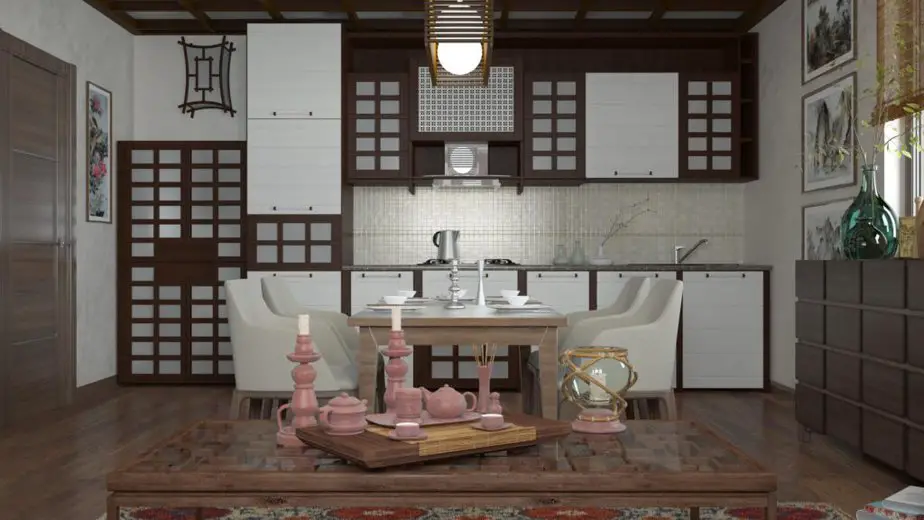
- Open Shelving: Incorporate open shelving to display essential kitchen items like dishes, pottery, and utensils. This not only adds visual interest but also makes items easily accessible.
- Minimalistic Decor: Keep decor minimal. A single ikebana flower arrangement or a simple painting can add a touch of elegance without overwhelming the space.
- Hidden Storage: Utilize concealed storage solutions to maintain a clutter-free appearance. Cabinets with sliding doors or hidden compartments help maintain a neat environment.
- Natural Light and Ventilation: Maximize natural light and ventilation. Large windows or sliding doors can bring the outdoors in and create a seamless connection with nature.
- Functional Kitchen Island: Incorporate a functional kitchen island with clean lines and ample workspace. It can serve as a prep area, dining space, or even a communal gathering spot.

- Zen-inspired Elements: Infuse Zen elements such as small indoor plants, bamboo accents, and subtle water features to evoke a sense of tranquility and mindfulness.
- Minimalist Appliances: Choose sleek and minimalist appliances that blend seamlessly with the overall design. Appliances can be integrated into cabinetry for a cohesive look.
- Streamlined Hardware: Opt for simple and understated hardware such as knobs and handles. These details contribute to the overall clean and harmonious aesthetic.
- Natural Textures: Add depth to the design with textures like woven mats, tatami flooring, or shoji screens. These elements create visual interest and tactile sensations.
- Mindful Placement: Thoughtfully place items and tools where they are most needed. This practice aligns with the Japanese philosophy of “Kansei,” which focuses on the sensory experience.
- Calm Ambiance: Ultimately, the goal of a Zen-inspired Japanese kitchen is to create a calm and peaceful ambiance. Each element should contribute to a space that fosters mindfulness and a connection to the present moment.
Description of Japanese Cuisine Design
There are several basic design principles:
- This style is concise, assumes restraint, and has a minimum amount of decor.
- The interior uses natural and natural materials in the form of wood, jute, bamboo, or rice paper.
- In an already inhabited house, this option is also possible, provided that the ceiling will withstand the weight of the masonry, and the area of the room will not suffer much from its volume. It has its advantages: this is an improvement in heat and sound insulation due to the duplicate wall.
- Japanese-style kitchens are distinguished by the presence of free space, which is formed by dismantling the walls or using multi-level color transitions.
- In the decoration, beige, black, brown, green, or red shades are used.

Beige Japanese-style kitchen
Beige is the main neutral shade that can be combined with many colors. He has a calm energy and is considered close to the color of a person’s skin, so he is not able to concentrate on himself. In the interior of the kitchen, it can be present in large quantities in the form of finishing materials or a set of facades. Best of all, the beige palette is combined with a close-to-itself brown, but the presence of contrasting tones is not excluded.
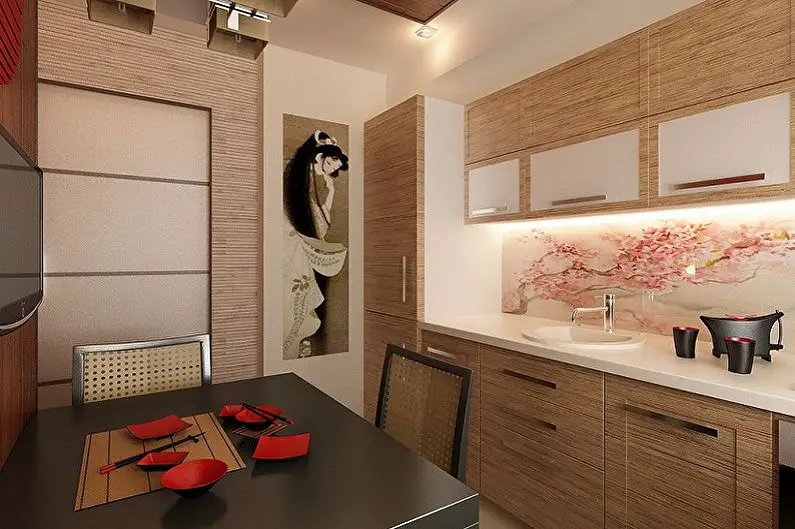
Red Japanese-style kitchen
The Japanese blushed with strength and masculinity. After all, even in the Middle Ages, people loved the component of fire that gives warmth and life, thinking of it as an image of harmony, and the success of the family. Inside, the read range can essentially breathe life into the circumstances, and show the main areas. The red color scheme will be completely combined with the tones of wenge and ivory.

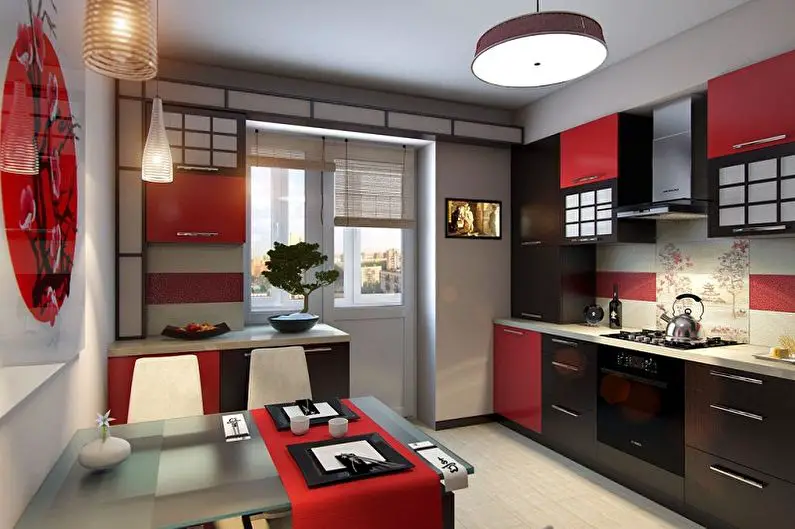
Brown Japanese-style kitchen
The tone makes staggering differentiations in the serene setting of Japanese cooking. It inspires a relationship with the dependability, and warmth of strong wood, and makes you center around settling on the correct choices. Be that as it may, an excess of it on the inside can cause gloom and dissatisfaction, so it is essential to pick the correct shade and associates, among which the best will be brilliant, sand, and green tones.
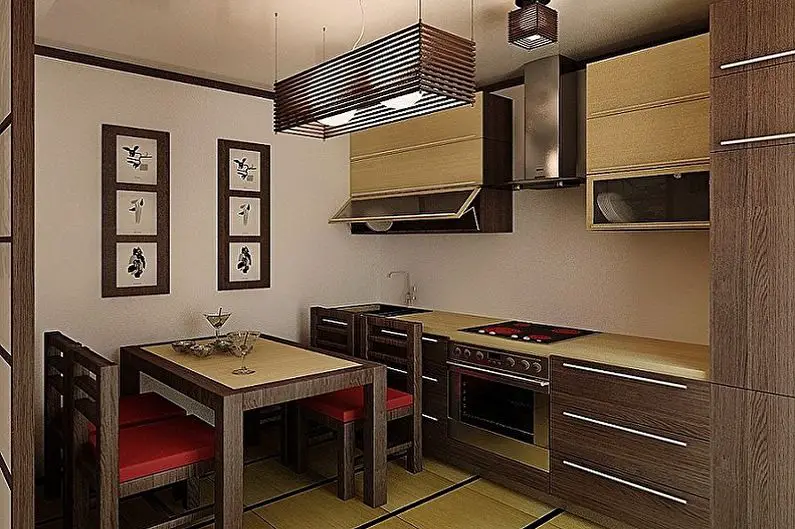
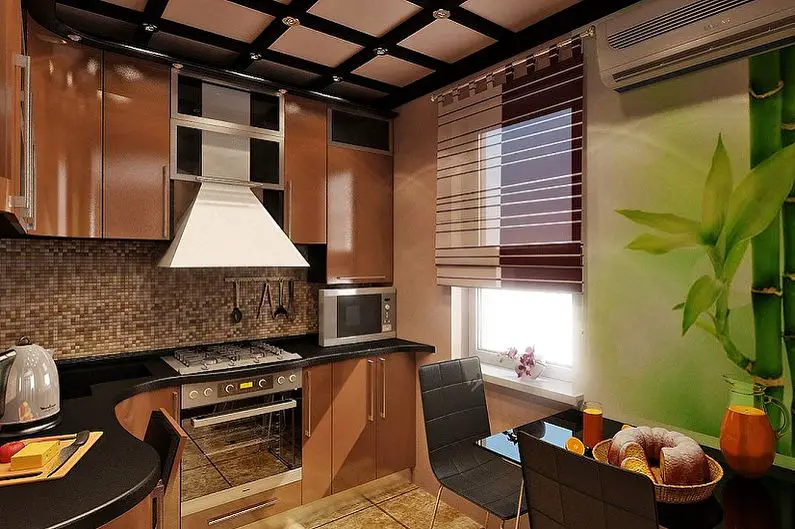
Green Japanese-style kitchen
The olive range on the Japanese inside looks very natural. Shading is related to nature, has a gigantic beneficial outcome on the passionate condition of an individual, quiets, and assists with diverting from squeezing issues. Be that as it may, use it on the inside ought to be dosed, so as not to cause an aloof state. The olive range will look much more expressive when encircled by woody surfaces that are near it, and the primary foundation can be smooth or light-dark.
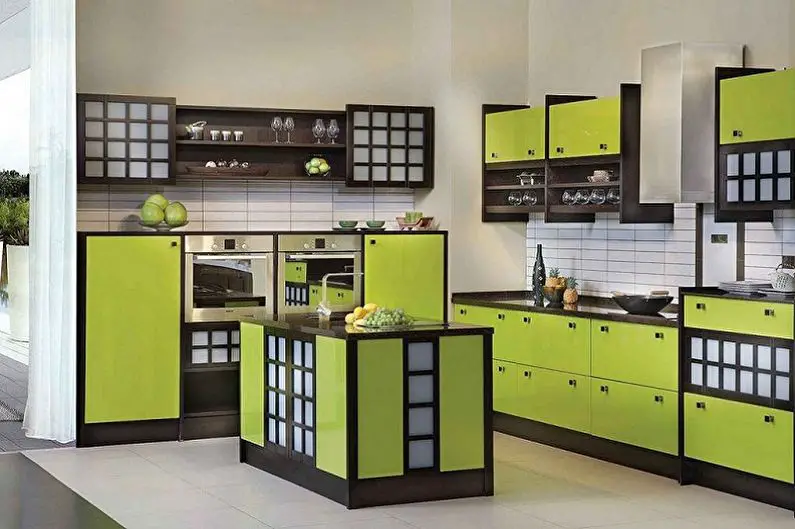
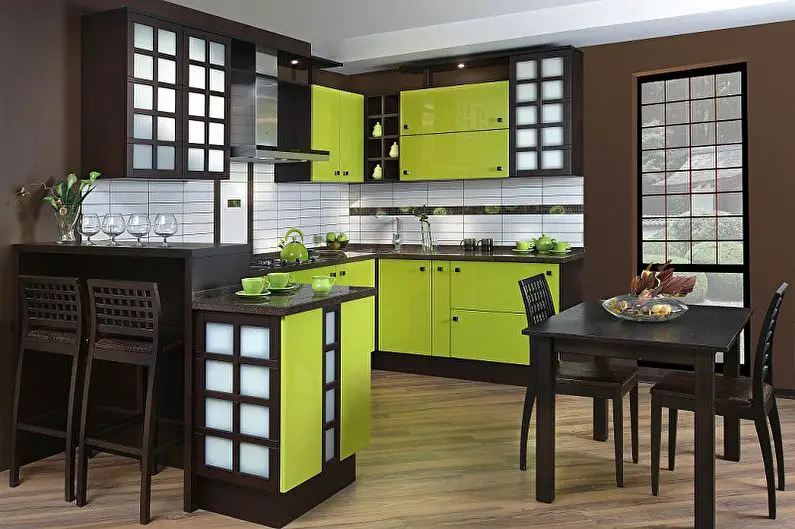
The design of the kitchen in the Japanese style of 2023 should comply with long-established principles:
- The shortfall of overabundance and evading mess falsely made the impression of an unfilled room with worked-in cupboards, open and shut racks, and the presence of just practical household items and dishes.
- The shading plan is quieted, quiet, the ideal difference is highly contrasting, and shades of green and red are satisfactory, yet very quiet. Beforehand, the style was contrasted and the work of art, however, the necessities for the shading plan of the works of art have changed, and the Japanese style has not gone through changes even in different nations.
- Japanese (board or screen) draperies are another element. They should positively be common and straight, without decorations, unsettles, and lambrequins. They can be utilized to design a window and an entryway and from a thick material method of drafting space, restricting zones for different purposes.
- A scene portraying nature or genuine Japanese images: Fujiyama, sakura, bamboo or trees, blossoms. Be that as it may, indoor plants should be chosen — they ought to be expressive, not lavish, and compare to a succinct style.

Unique furnishings, frills, reasoning, and flexibility are necessities for the plan of any room, paying little heed to its utilitarian reason. Sometimes (when the spending plan is restricted or embellishments can not be bought), you can disregard the plan prerequisites. For instance, in the kitchen, the primary patterns are restricted because of the little region, however, for this situation, it merits pondering the right decision of the style consistent.
Finishing and materials
Photos of the Japanese-style kitchen interior in 2024 demonstrate that only natural materials (stone, wood, bamboo) should be used in the design. But in modern conditions, there are enough good imitations of natural raw materials that can be used in creating the desired impression:
- porcelain stoneware;
- decorative tiles;
- wall panels and even wallpaper of a certain type.
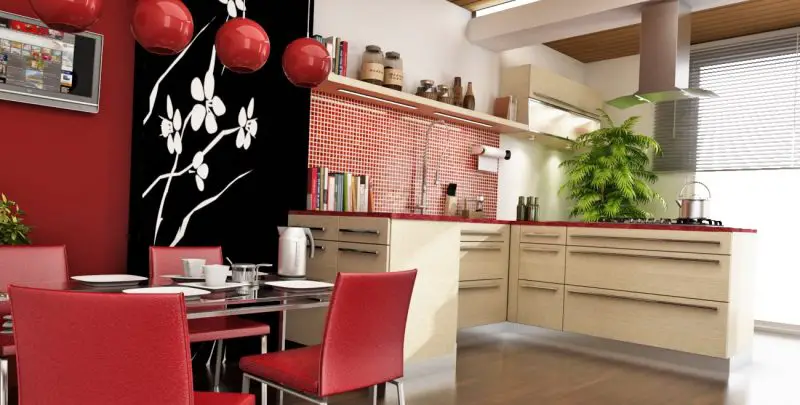
This will not give a 100% effect of authenticity and compliance with true Japanese traditions but will create an aesthetic visualization and compliance with the style in the opinion of a layman.
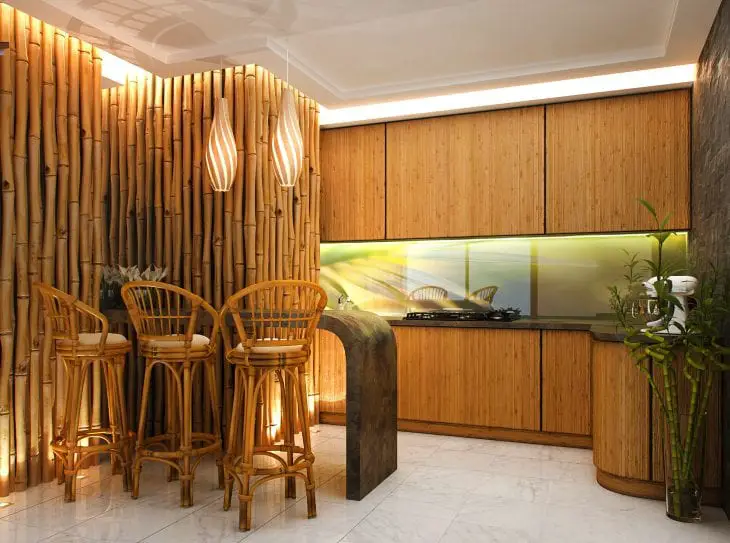
Japanese-style kitchen wall decoration
Master exhortation and photographs on the plan of the kitchen in the Japanese style of 2024 unmistakably show the wide prospects of utilizing present-day building materials to mimic and reproduce the trademark highlights. In the plan of the dividers, ornamental mortar is utilized with polymer-added substances that give protection from dampness and steam.

If you pick lovely pastel shades of beige, greenish, and earthy color, the match will be finished. White and dark (a conventional blend) will give the inside credibility, complexity, and congruity. Improving mortar in the mix with drywall will permit you to make specialties and boxes, boxes, and steps, which are trademark highlights of the Japanese inside. They are painted in the shade of the dividers, making a vacant space without furniture.
Japanese-style kitchen floors
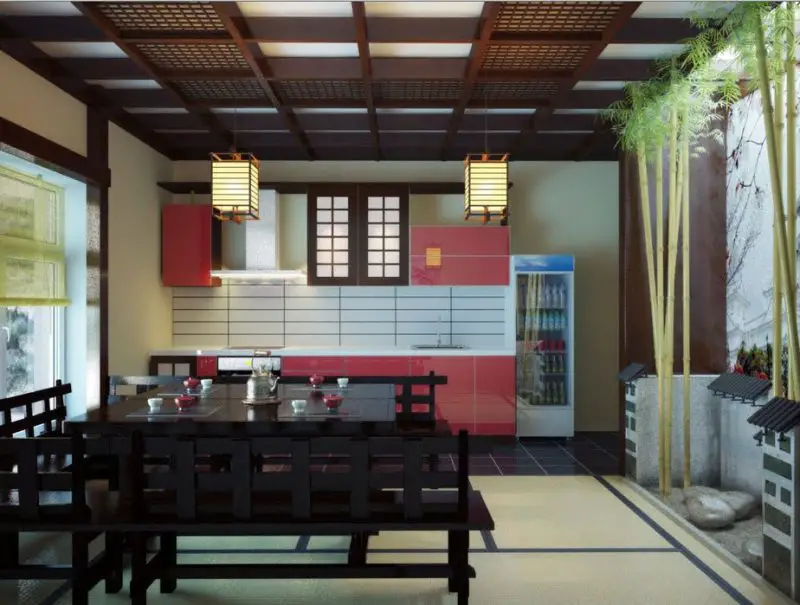
The best alternative for a Japanese–style kitchen is sections of flooring or parquet in the shade of normal wood with a shiny covering. Dull shades are frequently utilized, which are rehashed in the outfitting of the room.
Assuming the spending plan doesn’t permit the utilization of wood, the second most well-known material that relates to the style is floor tiles. Appropriate shadings: beige, light green, brown. Such floors are eco-accommodating, have high fire well-being, are not difficult to clean, and are serviced for quite a while. Be that as it may, if hefty items fall, the tile can be harmed. Another hindrance is the virus’s surface.
On the off chance that this truly turns into an issue, the floors ought to be protected, and the material ought to be purchased with a save if it is important to supplant 1-2 harmed plates. This is by and large the brilliant standard when working with ceramics – to have a stock. It happens that during the actual maintenance, the material breaks a lot, and tiles from another cluster might contrast in shading, so it’s smarter to take all the more right away.
Bamboo mats can be laid on the floors if this echoes the plan of the dividers or furniture exteriors. It is lovely to stroll on them, they add a feeling of solace and warmth. In the customary homes of the Japanese, mats were utilized for sitting during suppers and tea services, and they likewise rested on them.
The Japanese style of kitchen ceilings
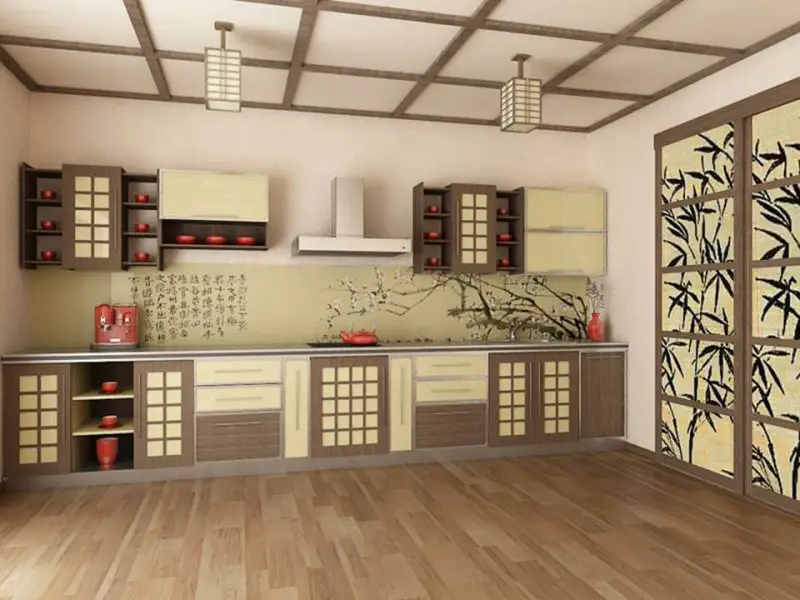
Drywall and stretch roofs are an incredible method to brighten the roof, albeit the Japanese lean toward wooden embellishment in the inside arrangement. The establishment of the roof should fundamentally incorporate the establishment of lighting: specialists suggest introducing spot spaces for each zone with its different practical lighting.
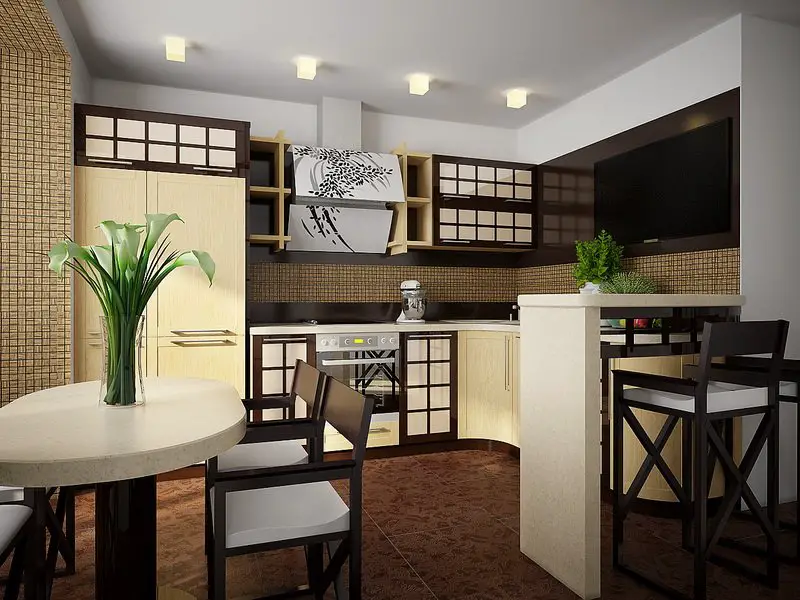
Mosaics, two-level forms of the roof in the Japanese style are unseemly — they shroud the space, and the fundamental standards of style correspondence are roominess and void.
What kind of furniture to choose for a Japanese-style kitchen
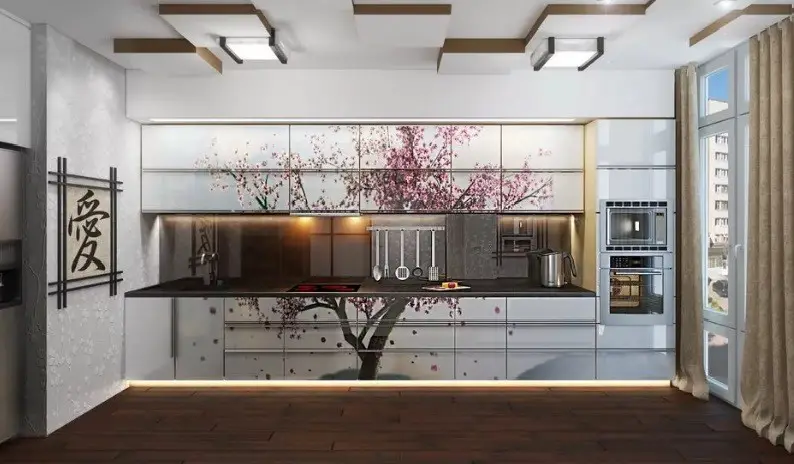
Japanese style doesn’t acknowledge monstrous furnishings. The kitchen set is made of normal wood or other regular material and has a severe layout and simultaneously an exceptionally exquisite look. Because of this, the room is loaded up with air and light.
The fridge and other home devices are incorporated into the headset and take cover behind the exteriors. The eating bunch is predominantly furnished with a table with a stone or wooden top and basic, not cumbersome stools or seats are introduced.
Since the planner doesn’t have the chance to utilize public kinds of furniture like tatami mats and floor coffee tables, suggestions for the choice of European choices have been created:
- structures of small height (as if the legs of the usual accessories were sawed off);
- comfortable, but low-lying pieces of furniture;
- open shelves alternating with wardrobes;
- obvious furniture items, without decor (curls, carvings, inlays, accessories, drawings, and protrusions are not allowed).

It is substantially harder to track down Japanese stuff on special — dressers on legs and chests that are utilized rather than seats. Yet, you can make a flight of stairs bureau out of the drywall and cover it with ornamental mortar, in case there is adequate room for this.
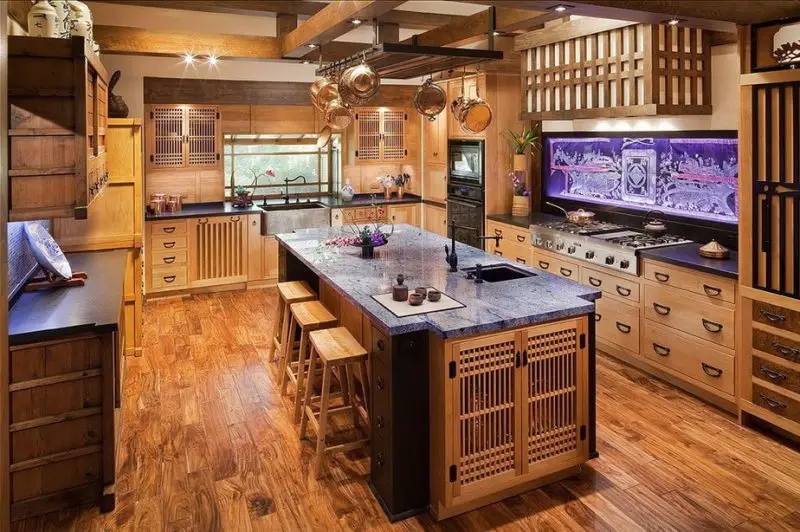
Important!
Lack of space can prevent the use of sliding partitions made of glass or bamboo — a characteristic feature of the chosen style. This means that zoning is impossible, and therefore a separate selection of items for each functional segment is impossible.
Japanese-style kitchen and lighting elements
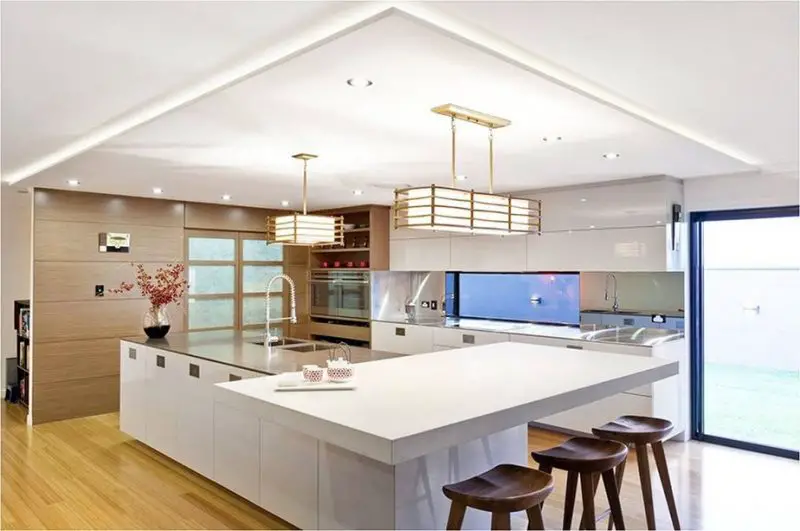
For Japanese insides, gadgets that will delicately diffuse light are fitting. For instance, inside roof lighting will be an incredible arrangement. Likewise, the kitchen can be outfitted with a focal ceiling fixture and spots situated around the border.
Lights with woven bamboo, straw Plafonds, or rice paper lampshades have an excellent look.
Since the Japanese style invites the presence of the right mathematical shapes, light sources contrast in the square, rectangular, or circular blueprints.
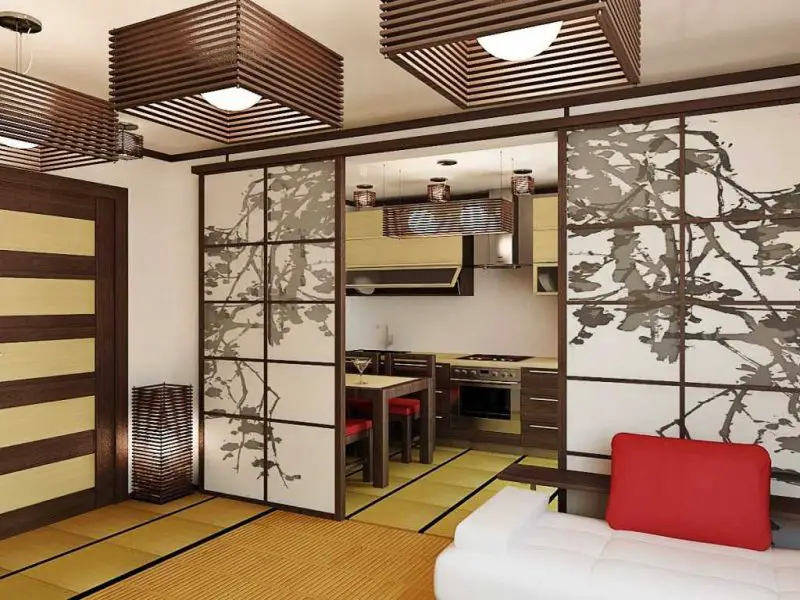
There is an adequate number of lights with lampshades made of paper, rattan, bamboo, straw, and other regular materials at a bargain. For individuals who are occupied with embroidery, it won’t be hard to make a particular embellishment, and this will give the ideal innovation.
Decorative elements and accessories
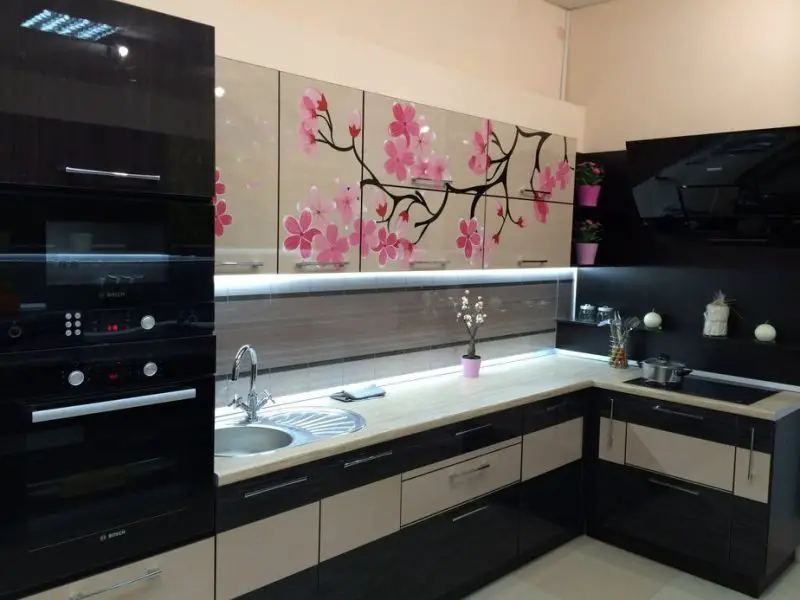
Without them, the inside doesn’t look total, even though it is shown that they don’t assume a significant part in Japan. This can be seen particularly obviously in the photograph of the kitchen plan in the Japanese style of 2024 with Sakura. The guidelines of ethnic style require the presence of only one critical embellishment on each divider.
Important!
Decorators in other countries do not always observe the asceticism inherent in the Japanese: they can use netsuke, figurines, bamboo mats, dolls in kimonos, and photos with national color in the amount that they consider necessary for the implementation of the plan.
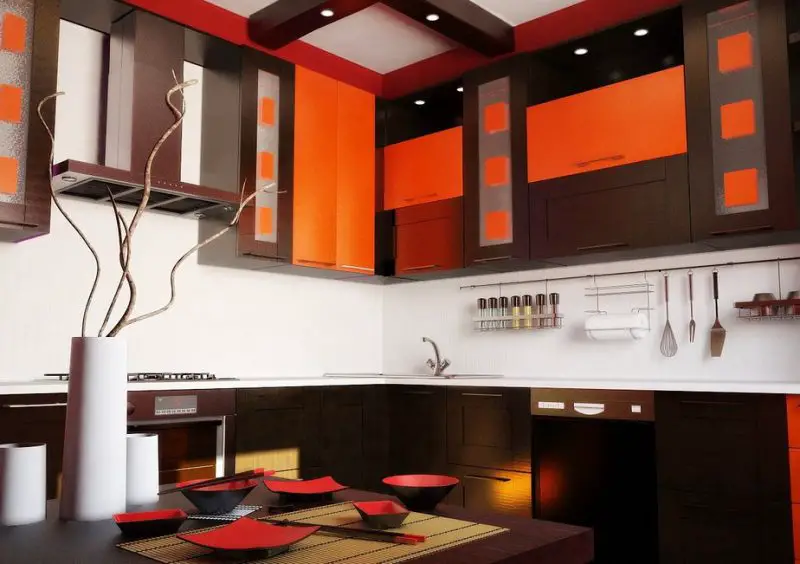
Looks with pictographs, paper fans, containers, bonsai trees, and kimono dolls are considered unmistakable provisions of the Japanese style. They are set in specialties, on the outside of furniture, and along with the remainder of the company, these are the visual methods for the decorator, architect, and craftsman to reproduce the ideal extraordinary appearance of the kitchen.
The stylistic layout permits the kitchen to track down a more expressive topical plan. For this reason, adornments are utilized as divider scrolls, jars, and artistic or porcelain puppets that can be set in specialties. True dishes will be a great enrichment. The table can be enhanced with a tea set, a sushi set, or a dish with products from the soil. Additionally, a tatami mat will stress the working or eating region.
Plants that are customary for Japanese culture, for example, ikebana or bonsai tree, will fit amicably into the inside.
Which curtains should I use?
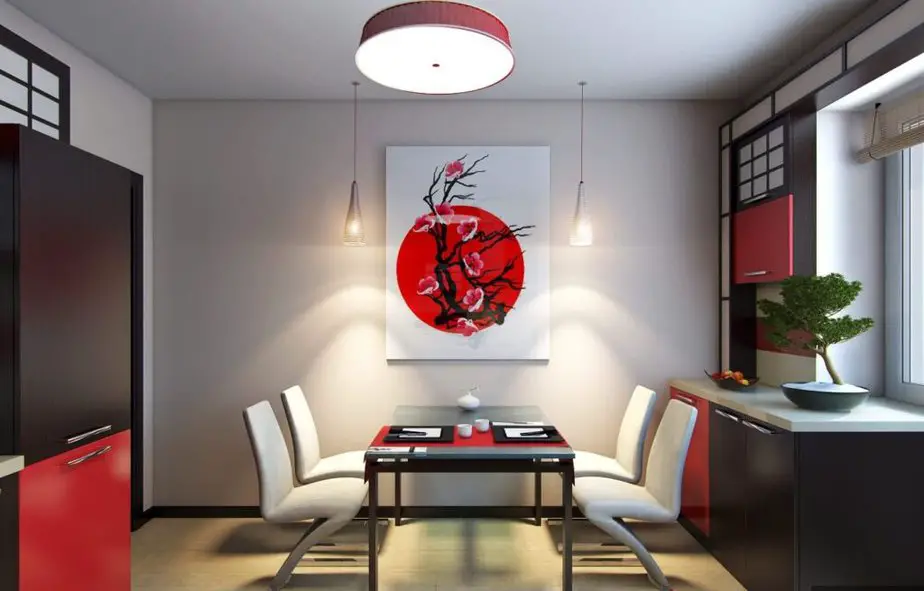
To complete the image of a Japanese-style kitchen, a competent window decoration is required. Curtains are almost an obligatory part of the oriental interior. In the manufacture of curtains, light textiles and natural materials such as bamboo, rattan, or rice paper are used.
Japanese Kitchen Design Ideas
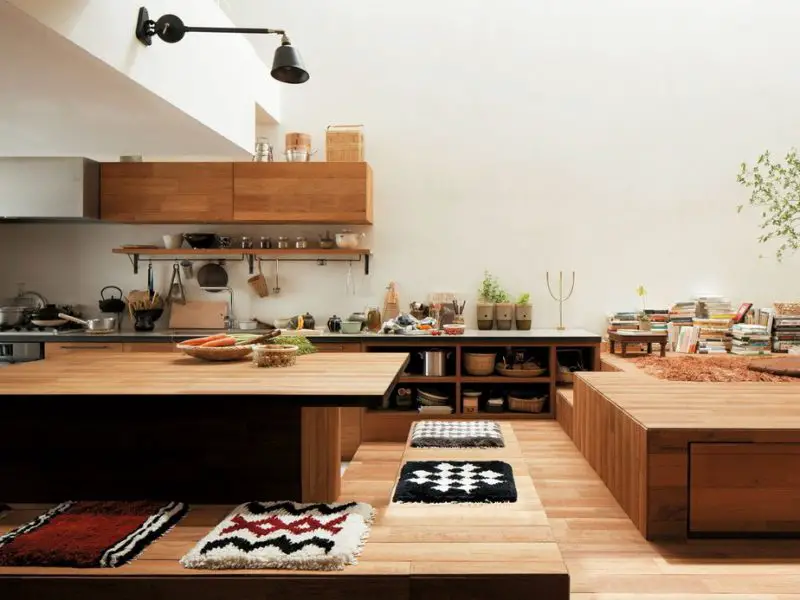
The stylistic layout permits the kitchen to track down a more expressive topical plan. For this reason, adornments are utilized as divider scrolls, jars, and artistic or porcelain puppets that can be set in specialties. True dishes will be a great enrichment. The table can be enhanced with a tea set, a sushi set, or a dish with products from the soil. Additionally, a tatami mat will stress the working or eating region.
Plants that are customary for Japanese culture, for example, ikebana or bonsai tree, will fit amicably into the inside.

In the modern design of the kitchen, there is an unusual decor in the form of skillfully made samurai blades that shine with a perfectly polished surface. Stylized Japanese kitchen knives perform an applied function and enrich the surrounding interior.

Japanese-style kitchen 2023 is a popular trend in interior design. Designers and apartment owners often turn to him. This style is in demand along with other equally well-known ones at present. A Japanese-style kitchen with an interior thought out to the smallest detail allows you to give the atmosphere an oriental spirit, give the room a unique grace, and create a harmonious atmosphere in which all family members will be pleased to be.

I joined Appartenville in February 2021 as a content editor. After studying English literature at university, I worked as an e-commerce website editor, content author, and purchasing intern for several independent luxury and lifestyle retail companies. My role at Appartenville combines my love, experience, and passion for the world of design and the desire to create inspiring written content. As for my personal style, I am a big fan of color and drawing, especially I like the pastel color scheme. I also enjoy discovering new trends, brands, and products, whether it’s fashion, interior design, or lifestyle my wish list for buying new things is endless.
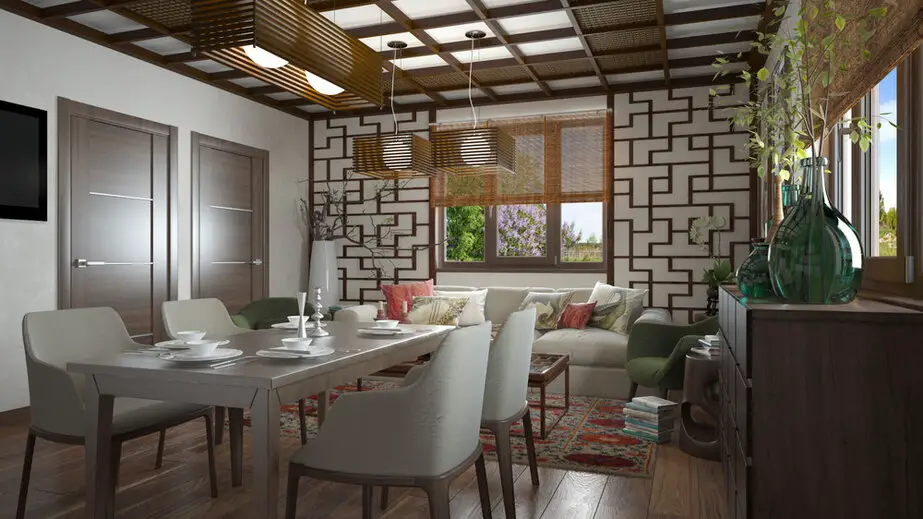

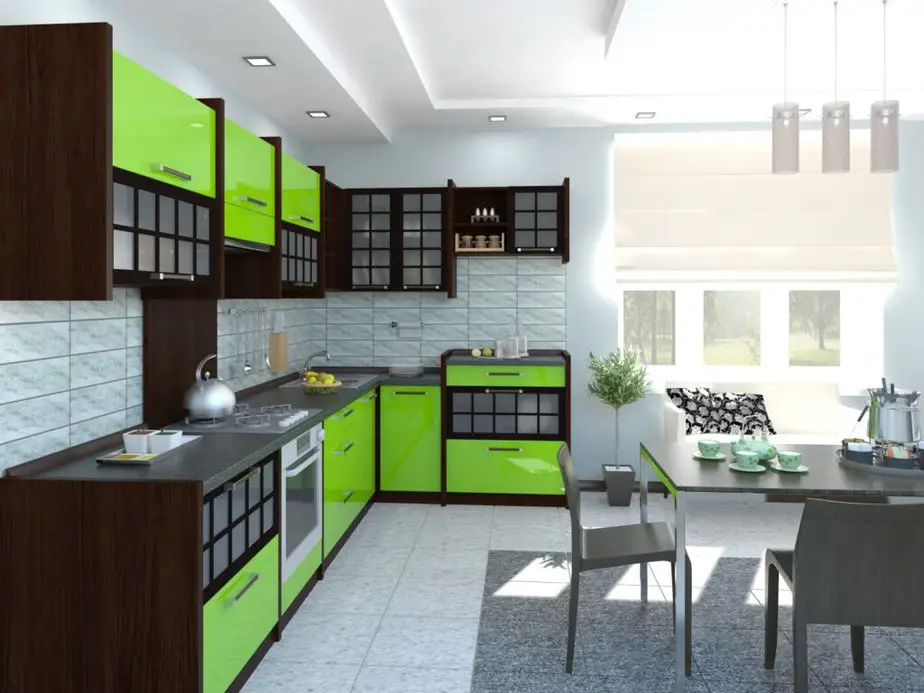
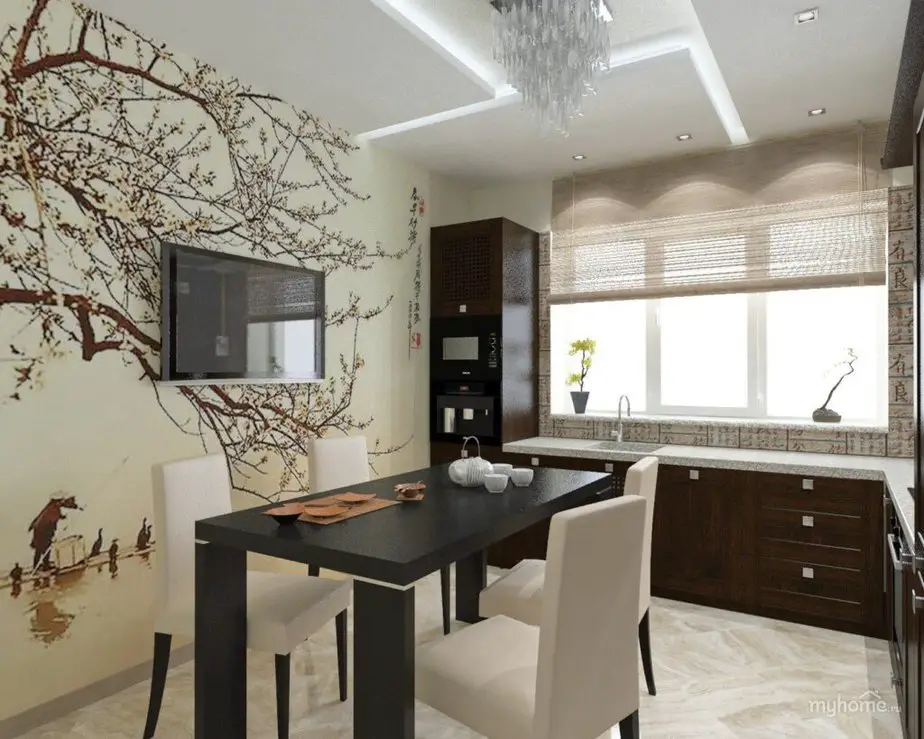
Leave a Reply